The OpenSolaris development community launched version 2008.11, its second release ever, Wednesday. The new version boosts hardware compatibility and brings some impressive improvements that illuminate the potential of OpenSolaris as a desktop platform. It's still not capable of replacing Linux on the desktop, but it shows promise.
OpenSolaris is Sun's desktop-oriented open-source distribution of the Solaris operating system. It is designed with a strong emphasis on ease of use and is intended to provide a fully functional desktop system right out of the box. It includes the latest software and offers a diverse assortment of applications ranging from development tools to multimedia players.
OpenSolaris emerged from Project Indiana, an effort to reinvent the disparate open-source Solaris bits as a cohesive desktop solution that could be installed from a Live CD. Led by Debian luminary Ian Murdock, Project Indiana was intended to serve as Sun's answer to Ubuntu. Despite the lofty and compelling vision, the project has had difficulty gaining traction outside of the existing Solaris community. It is still a very young effort and has a long way to go before it lives up to its potential.
Hardware compatibility
We tested the first release, version 2008.05, earlier this year and encountered several difficulties. In 2008.05, the network "auto-magic" system delivered a distinctly unmagical user experience, and there were several other minor hardware compatibility issues that I encountered during my tests. These problems appear to have been resolved and did not show up in 2008.11. Networking worked perfectly right out of the box.
Several new hardware features have been added, including support for suspend/resume, 3D graphics acceleration, SD cards, and improved audio support. That said, OpenSolaris is far from providing compatibility with the wide range of hardware that is supported by Linux, and these hardware features still only work on a limited selection of devices.
ZFS snapshot visualization
When looked at the first OpenSolaris release, we suggested that its potential for success would largely be based on how well it exposes its unique underlying platform features to end users. One of the most impressive technologies in Solaris is the open-source ZFS filesystem. It has a sophisticated storage pooling system and a number of other nifty features, including support for rich snapshotting. OpenSolaris 2008.11 brings that functionality to the surface with a ZFS snapshot visualization feature that is integrated directly into Nautilus, the GNOME file manager. We took an early look at this feature several months ago when it was still a work in progress.
To enable support for ZFS snapshot visualization, the user has to click a checkbox in the simple Time Slider Setup tool which is on the Administration menu—no arcane command line steps or configuration file editing is needed. After it has been turned on, it just works. You can click the snapshot visualization button in the Nautilus toolbar, and a slider will appear that the user can drag to go back in time and see previous versions of the directory's contents.
Packaging
The OpenSolaris packaging system, which is called IPS, also got some improvements in this release. There is a new graphical update manager that will notify users when new software is available. The package management command line tools feel a lot like APT and works reasonably well. The graphical package manager is a bit like Synaptic and is also quite good.
A major weak point for OpenSolaris is its limited support for third-party software. There are some new applications included in 2008.11 and some new software in the system package repositories. One of the major additions is Tracker, an open-source file indexing and search tool. Some of the new desktop applications that are available from the repository include the Songbird media player and the Transmission BitTorrent client.
The new version also includes updated versions of some major applications. It ships with Firefox 3 and GNOME 2.24. OpenOffice 3.0 is not included in the default installation, but it is included in the main repository.
Although OpenSolaris includes a lot of useful things, it still only has a slim fraction of the number of packages that are available for the major Linux distributions. The total number of packages in the main OpenSolaris release repository is 1,500, but Ubuntu has over 20,000. Sun has several strategies for boosting the number of packages that are available for OpenSolaris.
This release introduces several new package repositories that can be used alongside the main repository. The new "contrib" repository is for community-maintained packages that haven't been approved for inclusion in the main release repository yet. The new "extra" repository contains proprietary software such as the Adobe Flash player and other applications that can't be freely redistributed.
There is also a new "pending" repository that contains packages that are automatically generated from source code at SourceForge and other locations. The pending packages aren't intended for production use and can eventually be moved to the main release repository after they are tested by developers.
The relationship between these repositories and the process that is used to vet packages and make them accessible to end users is somewhat complex. Sun developer Glynn Foster pointed me to an excellent overview that neatly illustrates how it all works. It's evident that a lot of solid planning and engineering effort is being poured into solving OpenSolaris packaging problems, and that's a very good sign.
Developing on OpenSolaris
Right now, most existing Linux users will probably have difficulty adopting the platform because of the gaps in available software. It's viability as a development platform will depend entirely on what tools you are using for development. It ships with Python 2.4, which is pretty stale by today's standards, but the main repository provides enough Python library packages to facilitate basic PyGTK+ development (Update: Python 2.5 is available from the repository). Its Ruby stack is very sparse and it lacks some basic components such as IRB and the Ruby GTK+ bindings. The repositories are also missing a bunch of other basic stuff that I require for development, including GVim and Bazaar.
If you are doing any kind of development that reaches outside of Sun's ecosystem, then you are much better off on Linux. If you are doing Java development with Netbeans, then the OpenSolaris repository has you totally covered. I was able to get a basic JRuby project up and running in Netbeans on OpenSolaris with very little effort.
Theming
There are a few things that haven't changed much from the last version that deserve a brief mention. As I stated in my 2008.05 review, the Live CD installer is really excellent and it provides an experience that is totally on par with Ubuntu. The look and feel of the system is also still totally great. The default theme, which is called Nimbus, is elegant and well-designed. There is also a new alternative dark version of Nimbus that is kind of hot but still in need of further refinement. There are a few new icons and also new translucent background images for the panels. The whole environment looks very smooth.
Conclusion
OpenSolaris 2008.11 is a very big step forward for Sun, but the relative paucity of available packages limits its suitability for the average user or application developer. Sun has some creative solutions to address that problem and clearly has a strong grasp of user expectations. OpenSolaris is making progress and is steadily becoming a more viable contender on the desktop. Major new features like the ZFS snapshot visualization that expose some of the platform's rich underlying functionality are a good sign that the developers are moving in the right direction.
The big question that all of this raises for Linux enthusiasts is obviously "Why should I care?" Linux distros already provide pretty broad hardware support and a much bigger selection of packages, so it's a fair question to ask. In my view, the advantage is that OpenSolaris provides another choice. It offers some different technologies, a different community, and a different approach to development. All of those things bring value to the broader ecosystem of open source software platforms. I think that it is impossible to overstate the importance of competition as an instrument of progress.
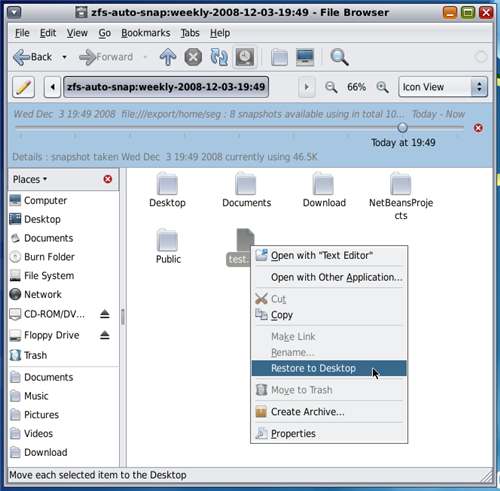


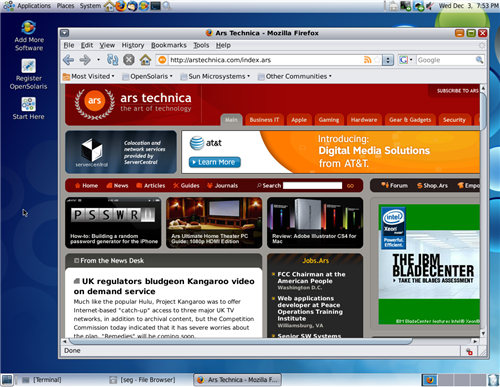
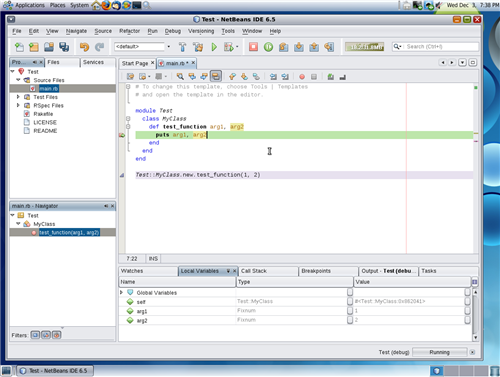
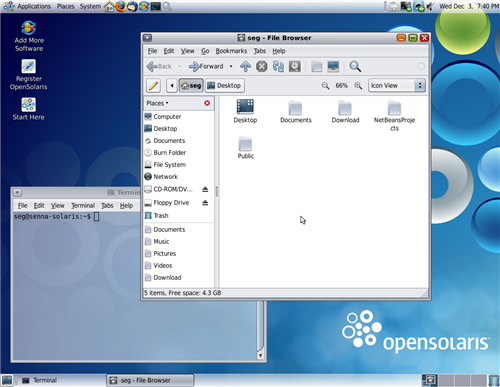
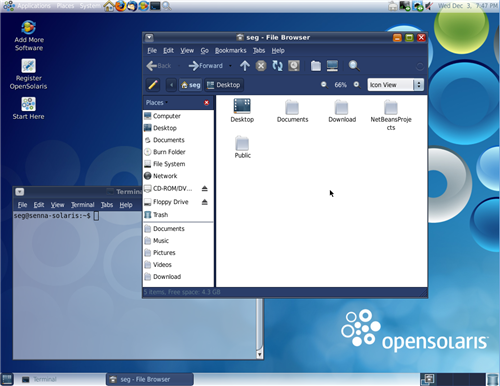
reader comments